French ASW warfare during the great war
Because of the considerable maritime traffic amount between the British Empire and its colonies, as with the USA, we often forget that many other belligerent nations had a sizeable trade fleet at the start of the war, and that German submarine warfare impacted them. Such was the case for France, which had in 1914 one of the world’s largest trade fleet, 5th rank among the future belligents. A large part of it was made of sailing vessels like most navies of the time. WW1 was the great purge for the sailing trade fleet of the world.
French wartime ASW fleet
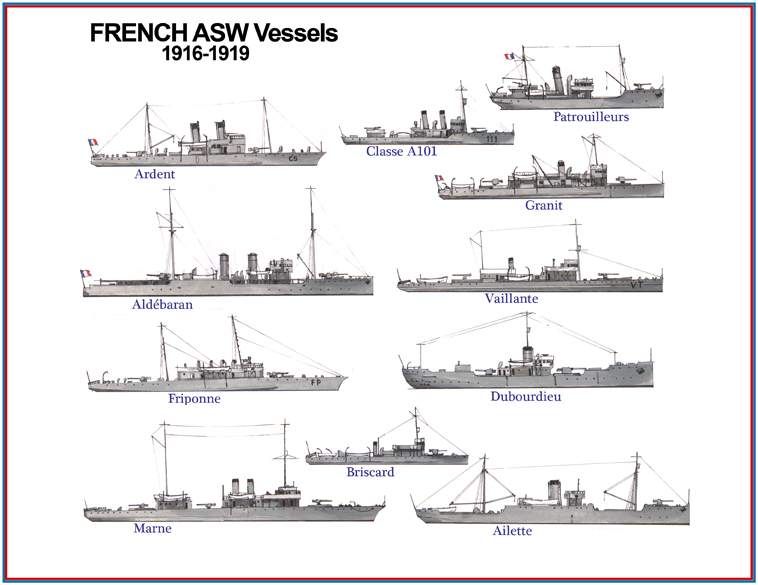
An overview of several classes of French ASW sloops, escorts, patrol boats and gunboats. Many were still active during WW2.
The French Navy concentrated her efforts on the Mediterranean and Western Atlantic, building and operating 81 dedicated military ASW gunboats and corvettes. This was a far cry compared to the British Empire and the USA, and it was reinforced by 8 British ‘Flower’ sloops in 1917, rearmed with French weaponry (Aldébaran class), as well as the single ex-Aubretia class Ville d’Ys in 1917. The USN also transferred 48 SC type sub-chasers. In addition, the French built 16 C101 type submarine chasers at the end of the war (in service from 1919), weheras many patrol vessels were made from civilian yards on civilian trawlers plans: 12 Navarin class, 8 Bouvines class, 10 Jacques Coeur class, 9 Gardon class, 8 Barbeau class, 30 Mauviette class, 4 Loup class, 4 Hippopotame class, 15 Pluvier class, and 4 Aurochs, 6 Clameur, 3 Athlete, 12 Crabe classes.
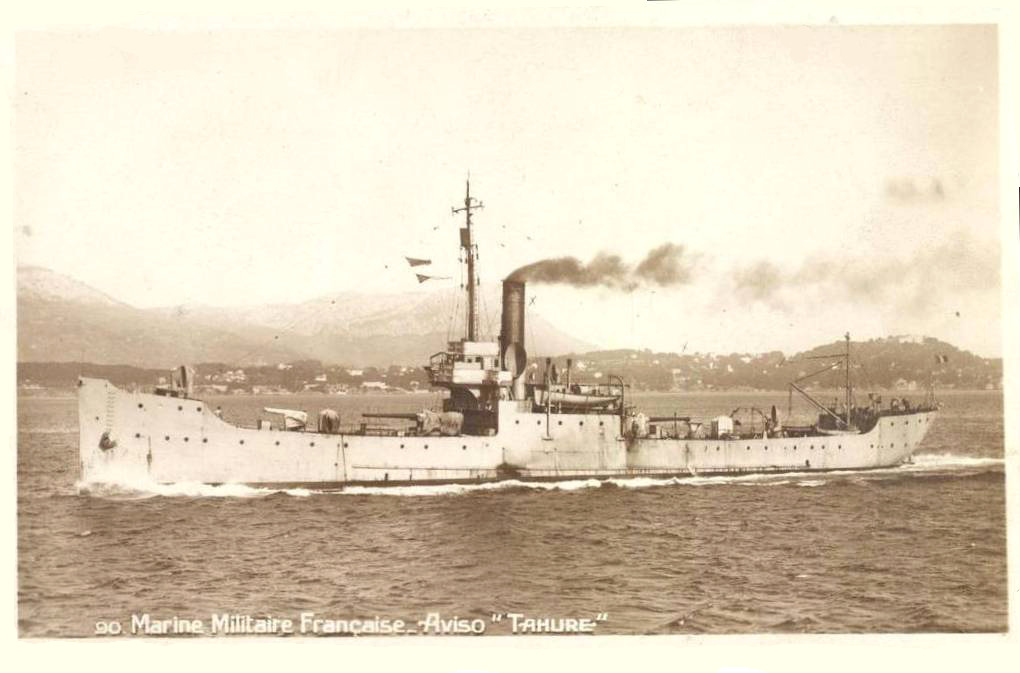
French Aviso Tahure (Arras Class sloops). Postcard Editions Debunne, Toulon. (cc). As so many of her type she was started at the end of the war and completed after, but served also in WW2 as an ASW patrol ship.
This made for a total of 100 civilian-grade patrollers. Also for coastal patrol, 70 ASW motor boats called “vedettes anti-sous-marines” of the V type (V1-73) were also delivered to the Navy, some by Vickers, Montréal. This picture would have not been complete wihout 250 auxiliary trawlers requisitioned, armed, and pressed into service (45 lost). We are going to detail these later in the article.
Production and conversion of escort units was entrusted to private civilian yards. They already had experience on small vessels easy to convert. Also some conventional arsenals, including Lorient, Cherbourg, Rochefort, La Seyne (Toulon) still had some non-enlisted personal left and could undertake the construction of smaller, simpler ships. Entering service at the end of the war were 6 corvettes of the Marne class (1916-1917), 30 Amiens (1916-1917), 2 Ailette, 3 Scarpe, 6 Dubourdieu, and Flamand (1917-1918) class, reinforced by ASW Gunboats such as the 23 Ardent (1916-1917) class, 9 Luronne/Friponne (1917-1918), and the 2 Valiant (1918) class ships. Some would be in service all the way through the interwar and second world war.
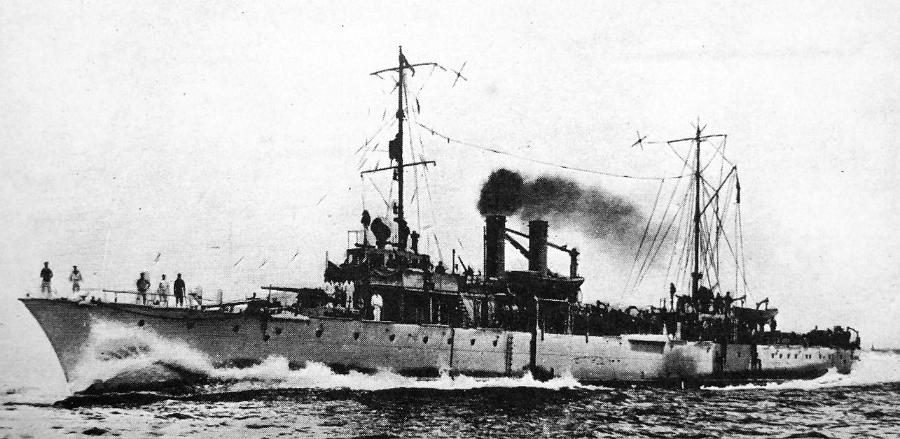
French aviso (Sloop) Marne in 1917. source
178 of the 360 U-boats sunk during the war were chiefly lost by mines (58) and Depth charges (30). The French however were late in use of depth charges, and their own model were not reliable. The British and Americans were contacted but declined to supply France, arguing their own needs were already barely covered.
French naval trade organization in 1914
Until 1913 the Ministry of the Navy assumed military tasks but also civilian, and therefore the trade fleet:
The minister was tasked for the status of seafarers, safety of Navigation, Fishery Police, public maritime domain protection, and also the the Ministry of Commerce, Merchant Navy and fishing industry.
There was a dispersion of civil naval services, which was an impediment to the development of a large fleet. Coordination and centralization of efforts ensured in the end the development of a large Merchant Navy, with a redistribution of competences in 1910. Centralization seemed impossible because of the special regime of maritime registration and eventually an under-secretary of state was created for the Merchant Navy, in order to achieve a unified administrative structure, by the decree of March 23, 1913.
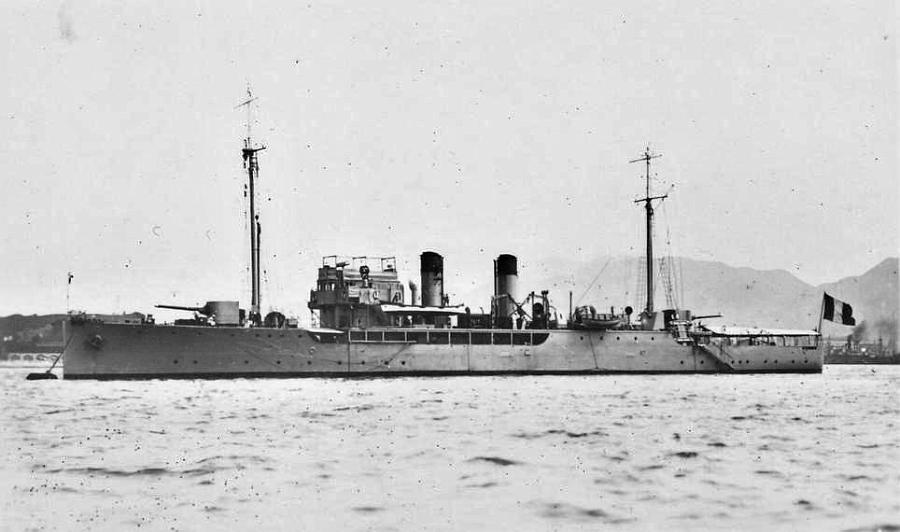
French sloop Regulus source
On August 13, 1913, a decree precised the services managed by the new entity: Staff service administration, seafarers, budget, general legislation, relationship with companies, piloting and sinking, fisheries services regulation and public domain and mutual maritime credit and insurances.
External services were taken in hand by maritime districts managed by administrators of the Maritime Registration. However in 1914 it was still considered unsufficient to develop and promote the French trade fleet, and a later decree in April 23, 1915 merged services of the Merchant Navy, creating the wartime maritime transport administration. Also during wartime, the under-secretary of state still existed, although under military supervision, and from 1918 it enderwent many minor structural changes.
French shipping in 1914
According to the Lloyd register of 1913-14 (see below), the French steamer’s Trade fleet comprised:
-20 wooden-hull vessels, 3,300 GRT, one composite one (219 GRT)
-189 iron-hulled vessels (202,346 GRT)
-777 steel-hulled vessels (1,587,243 GRT)
For a grand total of 987 trade ships above 100 tons; 1,793,310 GRT.
On the sailing vessels side, France had also 1,552 vessels for a total of 2,201,116 GRT.
This made for a grand total of 2,539 vessels above 100 tons. Below this, they were considerable numbers of fishing vessels, trawlers, tugs, pilot ships, barges, and quantities of light working vessels in all shapes and sizes.
This French shipping was quite active between France and North Africa, its main colony of Algeria in particular, but also shipping through the Suez canal, to Madagascar, and the far east colonies of Indochina. There was also a residual west-african traffic, notably towards Dakar. It should be noted that liners are included in this, since many were also freighters, with their fore and aft sections dedicated to cargo transport.
Compared to this, the industrial and economical power was often reflected in the strenght of the merchant navy:
> Combined with its colonies, UK had over 10,000 steam vessels registered for 19,849,167 GRT (1st rank)
> The German Empire 2,019 ships for 4,743,046 GRT (2nd rank)
> The US merchant fleet combined 1,871 ships for 4,302.294 GRT (3rd rank, but this will change quickly)
> Norway had 1,597 ships for 1,870,793 GRT (4th rank)
> Japan had 1,087 ships for 1,500,014 GRT (6th)
> Italy had 591 ships for 1,271,127 GRT (7th)
> Austria-Hungary had 419 ships for 1,010,847 GRT (8th)
> Sweden had 1,043 ships for 943,928 GRT
> Russia had only 716 vessels for 790,075 GRT
> Turkey had only 135 ships for a total of 111,848 GRT
Evolution of French ASW warfare
France has been one of the pioneers of submersibles (notice, not “submarines” as they were merely torpedo boats capable of submersion if needed), but she was slow to recoignize the threat posed by them for shipping. This was due notably to its own policy of using submersibles for coastal defence. Like torpedo-boats, they were designed to cruise, patrol and operate in advance or in, prepared positions for the fleet. Germany however, when swapping from the hunt of military vessels and auxiliaries, turned to shipping, and developed the concept of commerce raiders, ported from surface ships to U-Boats with great efficience.
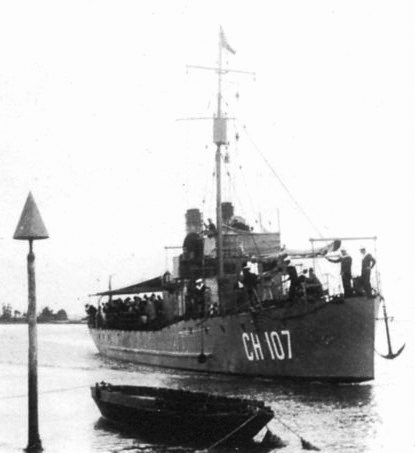
Photo of the C-107 during the interwar – credits Raphodon wikimedia commons (cc)
Areas of operations
By size, the British traffic was the first hit, and losses were much more considerable than for the French. Proximity to German bases, and later to Belgian ports that were known nests of coastal U-Boats rampaging in the Channel, posed a threat which was also recoignised by the French operating from Brest and Dunkirk, or coming from the Seine river into Nantes estuary. South to Britanny, traffic from Bordeaux and down to Spain was less subjected to U-Boat attacks, but it growed steadily until 1918, when a USN base was installed near the Arcachon basin, a great communication antenna complex raised to communicate with the fleet and French general quarters, and a floatplane base.
Indeed the greatest threat for French shipping was traditionally the Mediterranean. Until Italy choose sides, the Italian submersible threat was considered as very real, and afterwards only the Austro-Hungarians could cause some harm, locked into the Adriatic. But this “barrage” off Otranto never stopped the Austro-Hungarian submariners to try their luck into the Mediterranean and had some successes again both Italian and French shipping. Turkey was no threat on that level: The old Ottoman fleet, reinforced by German ships, was focusing on the black sea, and the fleet has not real modern submersible, but rather only one recent model, called Müstecip Ombasi, ex-French Turquoise, captured in 1915. The older one has been the Swedish Nordenfelt type Abdül Hamid, a 1888 steam submersible. But the Müstecip Ombasi has been used for reloading German submarines batteries until the end of the war.

Müstecip Ombasi, ex-Turquoise (source)
The relative proximity of the Suez canal area was a gift for German submarines which could be carried by rail in Istambul, rather than trying to force their way in via Gibraltar by sea. They were based in Istambul and could be resupplied in the Aegean, en route to their hunting area. Both the British and French were concerned by their traffic in and out of Suez, communicating with their Asian-Indian and Pacific colonies.
French ASW tactics
However it seems there was more indeed for the Admiralty concerns about the atlantic sector, which was reflected by the fact western ports and yards were mobilized to deliver these ships. And indeed this is confirmed in facts. The French still had to protect their shipping in the Atlantic, purchasing tractors, ammunitions and all sorts of hardware from the Americas, and for this, needed escorts. Since the yards were depleted of manpower, only limited numbers of ships could be delivered: About 17 sloops and 11 gunboats, which was little compared to Great Britain.
Therefore, to participate in submarine-hunting in the Atlantic and escorts, the British Navy transferred nine “Flower” class sloops while the derived Amiens class was built in all the available yards at the end of the war. Most of the efforts were concentrated in the 1917 and 1917-18 war programmes.
Before 1915, the Submarine threat was answered by virtually all light ships that were patrolling waters crossed by German U-Boats: Torpedo boats for the most, and destroyers. None of course were equipped to deal with submarines, gunnery was the main weapon against these, helped by their relatively slow diving time. Ramming was also an impromptu technique, when possible. From 1916, the threat was taken more seriously, and conversions of trawlers and tugs began. About 100 of these were armed with 100 mm naval, 90 mm army guns and 47 mm naval guns and machine-guns.
Tonnage was around 300-900 tonnes. Requisitioned civilian crews, and a small naval detachment to man the guns and a navy officer for advices and external communication. These “animal” series played the same role as British armed Admiralty trawlers and drifters, some even purpose-built but around 1,000 in total.
The need for ASW vessels was such that when the French secured the Greek Navy in December 1916, they took over the four 1885 gunboats of the Achelaos class, used for patols in the Aegean and returned to Greece in 1918. They resumed their service until 1930.

Help support Naval Encyclopedia !
From 1915 already serious efforts were made to acquire depht-charges, of the light model developed then, light enough to be carried by a single operator. Needless to say they produced little effect to submerged boats due to the massive damping effect of surrounding waters, compounded by the unreliable detonators of the time. Very few successes were registered until 1918, with gunnery and ramming still favourites among sub-hunters. In fact the very first recorded “kill” by depht charges was U-68, sunk by Q-ship HMS Farnborough off Kerry, Ireland on 22 March 1916. Later in 1917 the British experimented with indicator loops to track the magnetic field of submarines as they passed, coupled with controlled mines actioned remotelly from a land station.
French Hydrophones
The underwater hydrophone was almost a French invention: In 1914 French President Poincaré (a physicist by trade) procured fellow physicist Paul Langevin a facility to work on a method to locate submarines, using echoes from sound pulses. It was the infancy of the ASDIC. Langevin, working with working with Russian immigrant and electrical engineer Constantin Chilowsky, eventually came to a piezoelectric hydrophone using a vacuum-tube amplifier while the same piezoelectric plate could be vibrated to produce sound pulses.
It did not fare much after 1915 whereas the next year, the British took some ideas in the design and within the Board of Invention and Research, Canadian physicist Robert William Boyle teamed up with A. B. Wood to create a prototype tested in mid-1917. Australian physicist William Henry Bragg and New Zealand physicist Sir Ernest Rutherford already patented an early hydrophone design in 1916. By early 1918, both France and UK tests campaigns of prototype hydrophones led to a limited production, and the device known in both navies. It will evolved on the British side as the modern ASDIC, tested on HMS Antrim in 1920 and introduced from 1922. Meanwhile, hydophone were deployed in quantity on both sides of the Channel. The Royal Navy in November 1918 had 38 hydrophone officers and 200 qualified listeners in service.
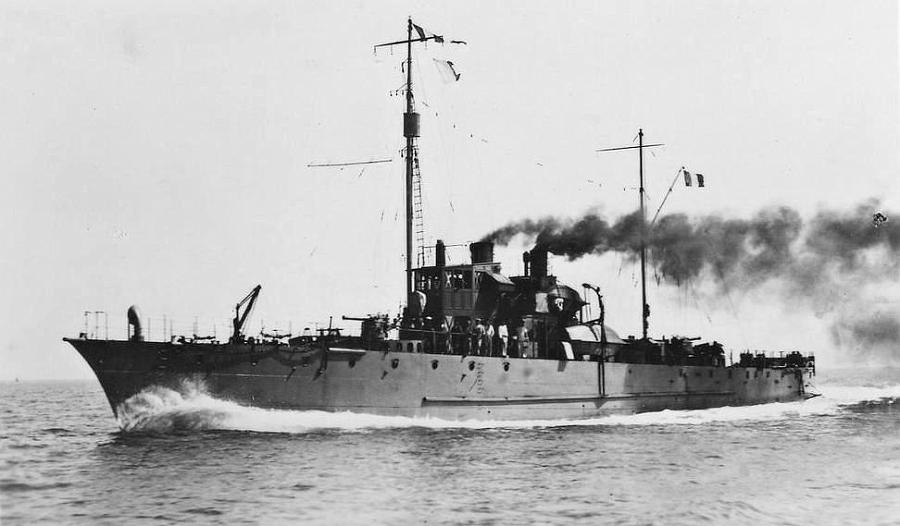
Gunboat Alerte – source
At the end of world war I, the U.S. National Research Council invited British and French experts on underwater sound to a meeting in the US with their American counterparts in June 1917, to study underwater detection systems. In October 1918 at last, a return meeting was organized in Paris on “supersonics” (echo-ranging), but only more R&D emerged from it and none was ever tested in actual combat missions when the war ended. Development would blossom in the interwar and culminate with the ASDIC-Sonar.
Until then early method to track submarines had rather been crude: A simple semi-submerged box, with another “pot” like an early phone, to listen the surface of the sea or a simple glass box to directly “see” a submarine underwater were only efficient if the ship stopped completely on a supposed location of a submarine. Better, a small single cylindrical ceramic transducer was sometimes used, or simple focused transducers dish or conical-shaped sound reflector to focus the signals. Low-cost, it was quickly adopted by the British and French.
Naval aviation was way better at spotting submarines. But they rarely hit their mark with their small bomblets and rather were useful to force a submarine to dive and keep it underwater until ships converged on the spot.

HMS Polyanthus -( Imperial War Museum) (cc). Late (completed postwar) ASW French sloops such as the Andromede, Aldebaran and later Amiens/Arras classes were based on this proven British Aubretia design, the original “flower class”. However there is no known photo showing French ASW vessels camouflaged. Thuis has contradicted the “Q-ship” nature, for deceiving enemy submarines.
French ASW aviation
The other aspect, often underrated, of WWI ASW warfare was the development of a patrolling naval aviation. Early planes were developed for reconnaissance, providing precious information to the fleet and this role was developped further during the interwar and made obsolete by the arrival of radars. However, planes, and especially floatplanes which can safely land at sea in case of a problem, were found excellent to spot submerged U-boats. Indeed seeing a submarine from above was way easier than from a ship, its vision blocked by waves and light effects, or added opacity from this angle. From above, this opacity was lessened to such a point the dark or metallic shape of a submarine could be seen by clear weather miles around.

Donnet-Denhaut DD.8 floatplane – src ww1-planes.com
The development of French ASW aviation concided with the developmenet of naval aviation, fro which the French had been recoignised pioneers, with Henri Fabre in 1910, making the first successful take off and sea landing. These first experiments were followed in 1913 by the sole Caudron Type K and the Type L serie, and the French Navy already ordered its first floatplane in 1912. Soon, François Denhaut would design a new hull, boat-shaped fuselage. He would refine hydrodynamic lift at take-off in 1912, to the point the old cruiser Foudre was chosen to carry observation seaplanes, 1911 Voisin canard. The Navy started naval reconnaissance exercizes in 1912 nd 1913. A single Breguet Aerhydroplane was also tested in 1913. At the same time, Farman developed the two-seat HF.14 floatplane.
But the Franco-British Aviation (FBA), founded by Frenchman Louis Schreck in London, but industrial activities were soon relocalized in France. His seaplane was based on the Donnet-Lévêque Type A, and soon in 1914 gained recoignition and he won navy contracts for coastal patrol seaplanes. To the FBA Type A of 1914 succeeded the Type B in 1915, Type C in 1916, Type H (the most produced with over 1,400) and the Type S in 1917 and up to the end of the war. These were 2-seats side by side pusher biplanes, with a central floating hull and two underwings floats. The company manufactured less planes after the war and eventually fell into bankrupcy in 1931.
Another famous seaplane in use by the French Navy was the G. Levy GL.40 (about 200 made 1917-18), and the same year, Tellier entered the fray delivering circa 180 T1, T6c and T3. They also had the same configuration as the FBA and were derived from the same Denhault model. The later was known as Donnet-Denhaut, founded in 1914 by Jérôme Donnet (formerly of Donnet-Lévêque) and Dehault, the engineer that invented the floating hull, and soon from 1915 to 1918, the 1085 planes of the DD.2, 8, 9 and 10 models formed the bedrock of the French ASW patrol force. Also to be noticed, the Borel hydro-monoplane 1911 (circa 150 delivered), a two-floats one-seater monoplane used for reconnaissance and the Borel-Odier torpedo floatplane for antiship warfare.
More rare, other manufacturers produced seaplanes in small numbers, like the Hanriot HD.2, a fighter seaplane used by the US Army in 1918, or the Nieuport-Astra Carton-Pate military twin-boom floatplane of 1915, SPAD S.XIV seaplane fighter of 1918 (40 delivered), Paul Schmitt PS7 seaplane bomber (circa 30) or the very rare and advanced Galvin HC (1918).
It should be added as a final note that the French Aérostation Maritime (Fleet air arm) also operated dirigibles (airships) for long range patrol, like the British and Germans did. The company was named Zodiac, and is known a well-known manufacturer of inflatable speedboats. But overall, around 4,000 floatplanes and seaplanes were manufactured by several French companies, most of the successful Denhault model, widely exported to all allied naval air forces. They competed with the US-built Curtiss and large Felixstowe, the latter equivalents to the WW2 PBY Catalina in ubiquity and size.
French ASW weaponry
French light naval guns
By 1916, gunnery was the main ASW weapon, and sloops and gunboats were used for this. A spotter was mounted on a surelevated position to catch the low silhouette of a submarine, which at that time cruised on the surface at all times and only dive when required. Hydrophones were started to be introduced from 1917 under allied influence, as well as depht charges.
The main naval gun used on most French ASW vessels was the 100 mm/40 gun (4.7 in):
French depth charges
After sending requests to the US and British allies for depht charges, refused as production was unsufficient, the French eventually started to copy the the British model Type D, which was the latest “on offer”. They were produced by the company Guiraud. They were stacked in stern racks. The French also purchased 136 A/S depth charge throwers (DCT) from Thornycroft in 1918.
-The French started to use the Guiraud 40 KG (90 Ib charge), introduced in 1915, which was adjustable to 110 feet (35 m), but it used an obsolete torpedo detonator as part of the pistol and was not considered reliable.
-Later this year was introduced the Guiraud 70 KG (156 Ib.), which had the same settings but also had the same limitations. In addition their feeble TNT charge only worked near the surface.
-Only after the war, the more potent Guiraud Model 1922 200 KG was introduced. It entered service presumably in 1923 but design started in 1920. It was a 50 x 88 cm (19.7 x 34.6 in), 573 lbs. (260 kg) DC with a 441 lbs. (200 kg) TNT charge, a Sink Rate/Terminal Velocity of 10 fps (3 mps), and for settings, had originally 100, 165, 250 and 330 feet (30, 50, 75 and 100 m) or on the improved model 130, 260 and 330 feet (40, 80 and 120 m) depht. They were dropped from destroyers sterns at 30 to 50 m (100 to 165 foot) intervals and equipped the French Navy destroyer, sub-hunters up to WW2.
In ww2 two other models were introduced, a lighter, 100 kgs model 287 lbs. (130 kg) in total, 25 x 84 cm (13.8 x 33 in). It was used on sloops and launches, or from depht charge throwers. A second model even lighter, 35 kgs (115 lbs. (52 kg) with a sink Rate/Terminal Velocity of 7.2 fps (2.2 mps) and 80, 165, 250 and 330 feet settings) was used on launches and carried by planes.
The French used the USN Mark I depth charge rack, it was developed by Lt. Cmdr. Ishwood, RN, and was installed on French destroyers and ASW vessels from April 1918 onwards. It was produced to around 10,000 and widely equipped the allied ships.
It was designed after the rejection of the British sling system to hold a single DC. The model evolved on French DDs of the interwar to enclosed roller chain racks holding 12 to 16 DCs. No Depth Charge Projectors were available to the French until the 1930s, whereas Thornycroft DCTs were purchased in 1918, but non was installed before the end of the war.
During the interwar, a modernized version was designed for the French Navy, able to throw a 200 kg DC about 200 feet (60 m). But the most common model became the M1928, a powerful mortar on a trainable mounting, capable of throwing a 100 kg DC at 820 feet (250 m). About 200 were delivered, which saw service during WW2.
Ginocchio towed torpedoes (postwar)
The Ginocchio system was developed for the Regia Marina during World War I, but not adopted. Instead the French Government acquired the patent. It consisted of a towed torpedo, streamed over the stern in the relative position where a submarine contact was estalished. It was hoped it could strike the submarine and detonate.
However sea trials multiplied without impressive results, particularly because the device was unable to be set at a specific depht and was moving freely in the wakes of propellers turbuluences. It was evaluated by the French Navy well in the early 1930 but in both case it does not appear to have ever been operationally used, tried on Chacal and Bourrasque-class destroyers.
Technically the device carried a 30-kg (66 lb) warhead of Trinitrotolulene with inertial fuze. Depending of their overall weight, it was able to dive more or less: The “medium” (62 kgs) 15 to 37 meters and “heavy type” (75.5 kgs) 53 meters while their size range was 1.62-1.72 m. These devices were light enough to be man-operated.
Links/Read More
Lloyd Register world’s trade ships registry 1913-1914
On marine-marchande.net/
French merchant ships List used by the navy (pdf)
About French ww1 ASW weaponry
French Archives, trade fleet
Marine marchande française de 1914 à 1918
Marine marchande 1914-1918 Marc Saibene – Chasse Marée Editions
La Mar Mar, la marine marchande française de 1914 à nos jours – Jérôme Billard Editions E-T-A-I-, 1999
Les transports maritimes dans la guerre : contraintes et adaptations Marie-Françoise Berneron-Couvenhes >
On naval-history.net
//www.naval-history.net/xGW-FrenchNavy1914-1918.htm
//www.navypedia.org/ships/france/
//www.navweaps.com/Weapons/WAMFR_ASW.php
//www.ww1-planes.com/France/Zodiac-Airships.php
//clausuchronia.wordpress.com/category/patrouilleurs/chasseurs-de-sous-marins/
//archives-maritimes.blogspot.com/2011/07/14-juillet-1918-quentin-roosevelt-fils.html
//alamer.fr/
Lloyd’s registers archives
Sea transport & supply ww1
Research guide C9: The Merchant Navy ww1
Research guide C6: The Merchant Navy: The Mercantile Navy List
Merchant shippint ww1
Shipping losses 1914-18
British Tramp Shipping, 1750-1914 (Google book)
John Gardiner Conway’s all the world fighting ships 1906-1921.
Find and Destroy: Antisubmarine Warfare in World War I by Dwight R. Messimer
French ASW nomenclature

Author’s HD Illustration of the Ardent class gunboats (1916)
Sloop Flamant (1917)

Stern of the Quentin Roosevelt source
This first ship converted for ASW uses was the former fishery protection vessel Flamant, started in 1913 at Arsenal de Rochefort, construction stopped in 1914, resumed in 1917 and completed in April 1918. She was later renamed Quentin Roosevelt, to pay hommage to the former president’s son killed in action as a fighter pilot in the French Air force in July. She was used for patrols in wartime as she was capable of hunting submarines, armed with a single 75 mm and a 47 mm (rear). However she returned to fishery protection duty in peacetime. On 3 July 1940 she was seized by the British Navy which converted her as a training vessel. She was returned to France in 1945, stricken two years afterwards.
Specification of the Flamant:
> 585 tons, 50 x 8.4 x 5.8m, 1 shaft reciprocating, 2 Cyl. Boilers 1200 ihp, 14.5 knots, coal 105 tons, range 1200 nm @10 knots. Crew 53.
Marne class sloops (1917)
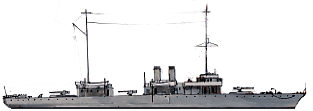
According to the 1916 war programme, six ships were ordered, about 600 tons, which differed by their machinery and funnels: Marne and Aisne from Lorient yard had one funnel while the two other pairs, from Rochefort and Brest, had two funnels. They were criticized for their weak armament, only two 65 mm guns. They had no depht-charges not any kind of sonar but they had an hydrophone (all but Marne). Their macinery was originally intended for the submarines Joessel and Lagrange, never completed during the war, and they all served with the Atlantic fleet, patrol force. The class comprised the Aisne, Marne, Meuse, Yser, Oise, Somme, and sometimes referred to as the French “River” class, but Marne was the first launched, in 25.11.1916. They were rearmed after the war with various formulas: The most common was four 100mm/40 guns, and one 75 mm AA or two 47 mm instead.
Oise and Meuse (BU 1938) did not saw world war two, as well probably as Aisne, discarded in 1939. However Marne saw action in Indochina, Can Tho, scuttled to avoid capture by the Japanese on 10.3.1945. Raised and scrapped in 1957. Yser was scuttled in Toulon, raised by the Germans, renamed SG 37 and BU in 1946. Somme was sold for scrap in October 1941.
Specification of the Marne class:
> 570 tons (Marne 600), 78 x 8.9 x 3.4m, 2 shaft reciprocating, 2 Normand/Du Temple Boilers 4000 ihp, 22 knots, oil 143 tons, range 4000 nm @11 knots. Crew 113.
Ailette class sloops (1918)

The 1917 war programme included the Scarpe and Ailette Avisos (“sloop”). The first looked like tiny “three islander” mercantile vessels to better lure the predators/submersibles out. The two 100mm/40 guns onboard were concealed behind shields fore and aft of the central island, in place of the storage bays. There were two 65 mm on the prow, hidden behind tarpaulins, but no DC or hydrophone. They were intended to serve as escorts, leaving an anemy submersible approach without noticing; Ailette and Escaut served in the Atlantic. Escaut was stricken in 1934 but Ailette was still active during WW2, broken up in 1941.
Specification of the Ailette class:
> 492 tons, 69.9 x 3.3 x 3 m, 2 shaft Geared Parsons turbines, 2 Du Temple Boilers 4000 ihp, 20 knots, oil 143 tons, range 4000 nm @11 knots. Crew 107.
Scarpe class sloops (1917)
These three ships were quite different than the Ailette. They looked properly military, with a flush-deck hull, wwere larger at 600 tons, 76 m, but they had the same armament, although one 65 mm less and depth charges instead. The Scarpe, Ancre (Lorient) and Suippe (Brest) launched in November 1917 and April 1918 for the two others had a single funnel, straight bow (Scarpe had a clipper bow), Du Temple boilers and Parsons turbines for 20 knots. They were capable ASW vessels, which served in the Atlantic. Scarpe was stricken in 1938 but the two others were active durng WW2. Ancre was stricken in 1940 and Suippe seized by the Royal Navy in June 1940, and bombed by the Luftwaffe in April 1941 off Falmouth. She was salvaged and resold for BU in 1957.
Specification of the Scarpe class:
> 604 tons, 76.2 x 8.7 x 3.3 m, 2 shaft Parsons Geared turbines, 2 Du Temple Boilers, 5000 ihp, 20 knots, oil 143 tons, range 4000 nm @11 knots. Crew 107.
Dubourdieu class sloops (1918)

This civilian-looking ships (similar to coasters) were avisos (sloops) ordered under the 1917-18 program and completed from June 1919 up to May 1920. Technically however they were launched from April 1918; The class comprised the Dubourdieu, Du Chaffault, Dumont D’Urville, Du Couedic, Duperré and Decres (cancelled), all built at Lorient shipyard. They served in the interwar as patrol vessels and were stricken 1933-39, apart Dubourdieu which was sunk at Casablanca on 8.11.1942. D’Urville was renamed Enseigne Henry and scuttled at Lorient in June 1940, refloated and BU in 1941. They were armed with a single 138.6 mm gun, a 100 mm/40 (5.4 in and 3.9 in) and depth charges racks.
Specification of the Dubourdieu class:
> 453 tons, 64.9 x 8.2 x 3.1 m, 2 shaft Breguet Geared turbines, 2 Du Temple Boilers, 2000 ihp, 16.5 knots, oil 140 tons, range 2000 nm @15 knots. Crew 74.
Ardent class gunboats (1916)

The Ardent class were the earliest and most active French ASW vessels of the war: Twenty-three ships ordered at Brest, Rochefort, Ch. de Provence, Ch. de la Gironde, Ch. de la Loire, ordered under the 1916-1917 programmes. They all share the same clipper bow but their superstructures differed along their own builders interpretation of this admiralty design. Both masts were stepped to the starboard of the centerline. Because of shortages or labour and materials, initially planned turbines were scrapped and reciprocating engines were used instead, stripped from reformed torpedo boats. They were armed by two 100 mm/40 naval guns, although Ardebt, Etourdi and Sans-Souci possessed 145 mm naval guns, and depth-charges.
Nine of the these were based in the Mediterranean, all the others patrolled the Bay of Biscay (Atlantic coast). At the end of the war and after, some were converted as minesweepers. Boudeuse was later sold to Romania along four Friponne class vessels (see later). These ships were stricken during the interwar, at the exception of Audacieuse (BU 1940), Tapageuse (BU 1944), Dedaigneuse was scuttled in Toulon Nov. 1942. She was later refloated and repaired by the Italians, served as FR56, then was captured by the Germans and served as a minesweeper M 6020 from 1943 and was probably sunk in 1945.
Specification of the Ardent class:
> 310 or 266 tons up to 400-410 tons FL, 60.2 x 7.2 x 2.9 m, 2 shaft reciprocating engines, 2 Du Temple/Normand Boilers, 1500-2000 ihp, 14-17 knots, coal 85 tons, range 2000 nm @10 knots. Crew 50.
Luronne gunboat (1917)
This single 266 tons ship was basically a diesel-powered Ardent, and she was built at Brest on the same plans under the 1916 program. She had the usual two shielded 100 mm/40 forard and aft, and depth charges racks at the stern. She was characterized by a large and small stacks for diesel exhaust. She spent in the interwar in service and saw WW2, mined off Lorient and BU in April 1941.
Friponne class gunboats (1916)

Eight 315 tons (empty) vessels very close to the Ardent but with a narrower and longer hull and Sulzer diesels. Friponne was like a prototype for these. Range, like Friponne was better thn the ardent, with an extra 1000 nautical mile thanks to the diesels. Four built at Lorient and four at Brest, part of the 1916 naval program. Five more were ordered but finally cancelled. They did not had a visible funnel except Chiffone, Enageante and Mignonne.
Six served in the Mediterranean and two in the Atlantic. They were armed with the same pair of 100 m naval guns and probably Depht charges although it is not specified by Conways. Surveilante rammed and sunk the Italian TB Scorpione by mistake 15 May 1917. Diligente was the only one built with a straight stem. She was BU in 1946, as well as Engageante, Bouffonne and Surveillante were bth stricken before the war. Chiffonne, Friponne, Impatiente and Mignonne were all sold in 1920 to the young Romanian navy, and served during WW2 and for three of them, the cold war, until 1984 (as auxiliaries).
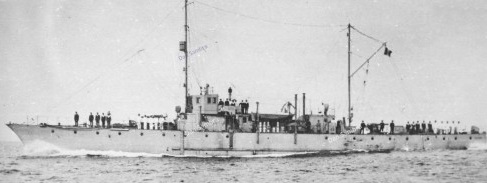
A Friponne class gunboat in interwar Romanian service, Ghiculescu (cc)
Specification of the Friponne class:
> 315 tons up to 410 tons FL, 66.4 x 7 x 2.8 m, 2 shaft diesels Sulzer, 900 ihp, 14.5 knots, oil 30 tons, range 3000 nm @10 knots. Crew 54.
Vaillante class gunboats (1917)

These larger gunboats were repeats of the Friponne, with straight stem and wider to accomodate twice the number of diesels. As a consequence power rose to 1800 ihp, for 17 knots. They had a unique, small stack forward of the rear mast, same armament as before and depht charges. Both were built at Asrenal de Brest under the 1917 program, and they served actively during WW1, the interwar, and WW2. Conquerante was seized by the British in July 1940 during Operation catapult and and sunk at Falmouth in 1941 by the Luftwaffe. They were also in essence the last French ASW gunboats.
Specification of the Vaillante class:
> 457 tons FL, 66.4 x 7.9 x 2.8 m, 2 shaft diesels Sulzer, 1800 ihp, 17 knots, oil 30 tons, range 3000 nm @10 knots. Crew 54.
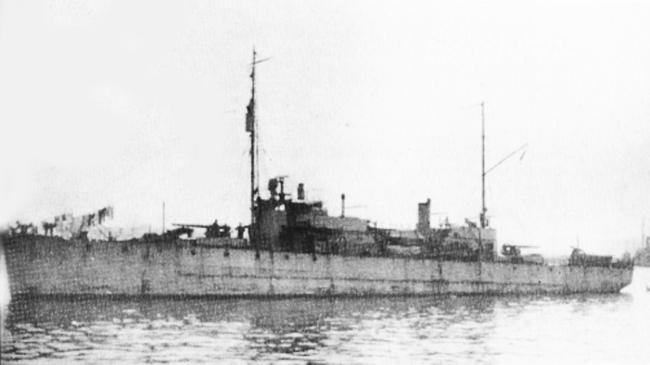
Gunboat Conquerante – Cropped and reworked from Jane’s page src
Trawler patrol vessels (1918)

A Canadian-built 1918 armed trawler. The Navarin should be relatively similar. These large patrol boats (640 tons) were launched between January and October 1918, the first entering service from September to the end of the war and afterwards. These twelve ocan-going trawlers were made by Canadian Car Co. of Fort Willian, and named after French forts and sieges.
Outside of 60 to 100 ASW patrol trawlers it seems 480 trawlers were also in service as auxiliary mine-sweepers.
Navarin class: 12 vessels, 640 tons, 1 shaft reciprocating engine 500 ihp, 11 knots, armed with a single 100mm. Custom-built, they were launched in January-October 1918, completed until September not in France but by Canadian Car Co. Fort William. They were named after French battles and sieges, but had poor stability. Two were lost in November in Lake superior, trying to reach Boston and the remainder were disarmed in Toulon. None saw action.
Bouvines class: Another order was passed to US Yard Foundation Co. of Savannah this time, 38 trawler-type patrol vessels still in 1918, but the Yard decided to create an extension to built them, and delays accumulated. In fact no ship was complete when the armistic was signed. All these ships were also named after French battles and sieges. The order was cancelled and only eight were eventually completed and sent to France, only to be resold by the Navy to the civilian market. The same fate awaited the other 30 ships, on the American market. They were all still extant in ww2. The Bouvines were 684 tons, 45 x 7.8 m ships with a 500 ihp reciprocating engine, enough for 9.5 knots. They were to be armed in France with two 100 mm naval guns, but this never happened.

Jacques Coeur class: Built in France in Brest, Nantes and Lorient on the west coast, these 700 tons ships were delivered at the end of the war and served as transport ships instead. Two became survey ships, three cancelled. This left ten ships, generally unlisted in 1937-38 and often renamed. D’Estaing (ex-Lapérouse) was lenghetened by 12 m and used as a survey ship under the new name of Bautemps-Beaupré. She was scuttled in Indochina in May 1945 to avoid capture by the Japanese. These ships were 51.2 x 7.9 x 4.2 m, propelled by a single reciprocating engine (1100 ihp, 12 knots), armed with two 100 mm naval guns and one MG (on paper). They were relatively fast for patrol trawlers, named after French historic sailors and captains.
Gardon class: These nine fish and insect named ships were built in 1917-18 and at last served in their intended role. Some were built in modest Fishing yards such as Port de Bouc and Le Troit. 665 tons, on shaft diesel (three had a reciprocating steam engine) propelling them to 10 knots, they had one 100 mm plus one 47 mm guns and ASW equipments: Depth charges and an hydrophone. They served actively until 1920 and were converted as transports, resold to the civilian market. Probably extant in WW2.
Barbeau class: Eight fish-named trawlers were built also in small civilian yards. 315 ton vessels, with a reciprocating steam engine rated for 365 ihp and 9 knots. They were armed with a single 90 mm army gun and one fast-firing 47 mm gun. They served in 1918 and were unlisted in 1919 and sold.
Mauviette class: These thirty trawlers were built by C. de la Mediterranée, La Seyne, Normand and Le Havre, many served in the Mediterranean. All named after birds, these custom-built trawlers were delivered in 1918. They were armed like the Barbeau class, but 420 to 460 tons, one shaft reciptocating steam engine fed by one cylindrical boiler, for 10 knots. They carried 120 tons of coal. Some became survey ships, like Mauviette which became Astrolabe and was sunk in 1944. Pie II became Estafette and met a similar fate in 1942 in Toulon (11 November).
French Tugs patrol vessels (1918-19)
These patrol tugs were built generally by small civilian yards, but also arsenals and “militarized” for their use. Built late into the war, they saw little service and lightly armed, with a field 75 mm or 90 mm army gun and sometimes a naval 47 mm QF gun as only armament against submarines. They did not carried hydrophones either and were resold to civilian owners soon after. Many were still active in WW2 under their new owners.
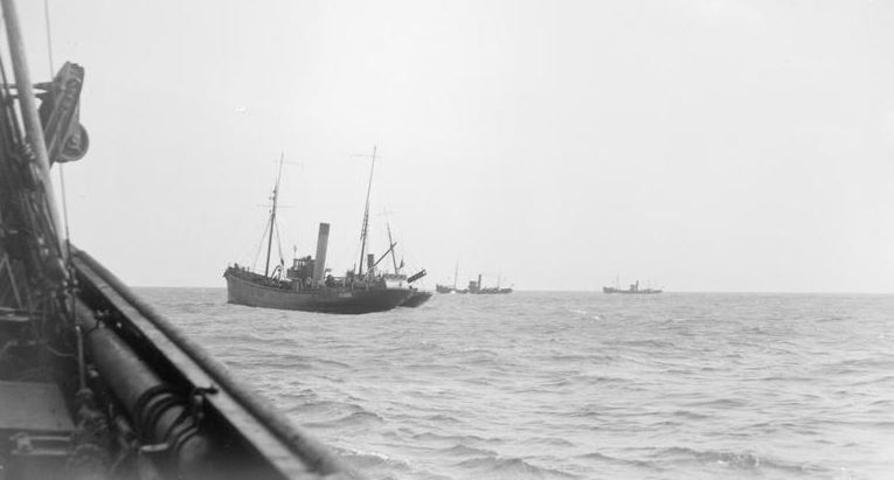
Patrol Tugs of the Atlantic
Loup class (1917): 283 t vessels, with a reciprocating steam engine and belleville boilers rated for 600 ihp, 10 knots. Armed with a single 75 mm (3 in) gun. Loup, Marcassin, Renard I and Sanglier were built at Chantiers de la Mediterranée, la Seyne (Toulon). Only Renard I was lost during WW1, on a mine, the other three seerved in WW2, at least until 1940 when Sanglier was retired and the two others were scuttled in 1942, later raised and rused by the Germans and sunk in an air raid in 1944.
Hippopotame class (1917): Four vessels from Chantiers de Normandie and St Nazaire on the Atlantic coast, Mammouth, mastodonte, Hippopotame and Rhinoceros were 970 ton, 1800 ihp (12 knots) vessels armed with two 75 mm guns. They served in both world wars.
Pluvier class (1918): Fifteen bird-named tugs completed at Ch. de la Loire and St Nazaire, in the 680-780 tons range, with 750 ihp (11 knots), probably armed with a single 75 mm. They served actively in WW1 and were for some unlisted in the interwar. Perdreau II was lost in a collision in 1918, Heron scuttled in Toulon in 1942 and Paon was sunk in 2.10.1944.
Aurochs class (1918): Four patrol tugs from C. de Bretagne. 290 tons, 650 ihp and 10 knots, armed with a 90 mm and 47 mm guns. Aurochs, Elan, Renne and Zebu also served in WW2, and two were lost.
Clameur class (1918): Six patrol tugs from C. de la Ciotat (azure coast) and C. de a Gironde (Atlantic), 370 tons, two steam engines and two D’Allest boilers for 720 ihp and 12 knots, armed with a 90 mm (3.5 in) army gun. They were completed after the armistice and served in the interwar. Fracas was scuttled in 1943, Vacarme foundered in 1942 and Tumulte bombed in May 1940.
Athlete class (1918): Three 585 tons, 500 ihp (12 knots) vessels fro Arsenal de Brest, completed after the war and until 1919. Athlete and lutteur were scuttled at Brest in May 1940 (both salvaged and reused by the Germans), while Gladiateur V has been unlisted in 1920.
Crabe class (1918): Twelve Late war patrol tugs built by Arsenal de Brest and Lorient, on the Alantic coast. 360 to 370 tons, with Fraser and Chulner steam engine and a Belleville boiler (400 ihp, 9-10 knots) from the discarded cruiser Descartes. They were completed from the end of 1918 and 1920. They served during WW2 and six will be lost.
‘V’ type ASW motor boats (1916-18)
The V-type (For “Vedette”) motor launches were purchased either abroad in canada (51) or built locally on two main variants (19).
V1-V40 had a fairly complicated history. They were all purchased initially for the Royal Navy at Elco, Bayonne, but assembled in Vickers Canada of Monreal and eventually denominated ML-114 to 548 and later took over by the French and the firs cancelled the order. They were sent to the Dunkirk flotilla, tailor-made to hunt German coastal submarines in the channel. The first two reached Cherbourg in May 1916, and the other would serve on the Rhine after the war. 23 were sent to the Mediterranean. Three were lost in 1917. They were pretty heavily armed for their size and well equipped for ASW warfare, to the point they were certainly the best coastal ASW vessels in the french arsenal up to that point.
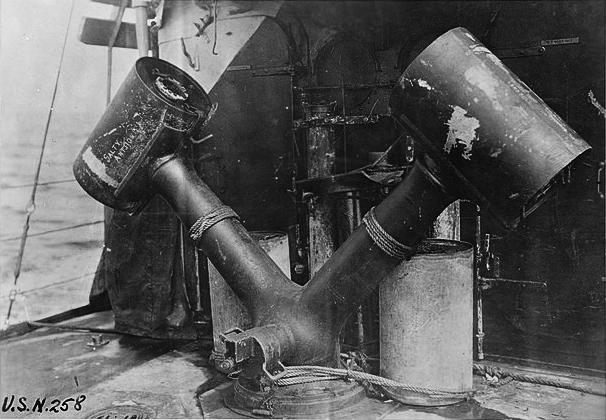
Y-gun, USN NARA archives – wikimedia commons (cropped)
Specification of the V1 class (1916)
> 40 tons FL, 24 x 3.8 x 1 m, 2 shaft petrol engines, 4400 ihp, 20 knots. 1x 75 mm, 1-2 MGs, Y-gun DC-thrower, C-tube ASW mortar.
-The next V41-53 were designed by M. Despujol and built in his yard at Neuilly/Seine near Paris. They were roughly similar bit 10 cm narrower but were given unreliable Panhard engines which delayed their completion until September 1917. They joined the Biscay Patrol Division and six others the Dunkirk flotilla. Three however were cancelled.
-The V54-61 built by Cornilleau shipyard near Marseilles were delivered between January and June 1917. They were slightly larger, 41 tons, 26.5 x 4 x 1.3 m, and were given two US-built Wolverine petrol engines, rated for 3600 ihp total, enough to bring them to 16.5 knots. Armament seems to be the same as other series. They all served in the Mediterranean, around the Azure coast.
-The last serie V62-72 were ordered directly by the French to Vickers Canada, ordered to be delivered in May 1918. However these 11 boats trials dragged on and they were only admitted into service two days after the armistice. They seems to have been slightly smaller at 23.4 m for 3.7 m and be capable of 19 knots. All these boats but two have been disposed of before 1925.
Completed after the war:
Amiens class sloops (1919)
Very comparable to the British “flower” class three island sloops. Thirty ships were ordered as fast ASW sloops and escorts under the 1916 and 1917 programmes, but completed from 1919 to 1921. Because of this, most saw action in WW2. They were named after northern cities either in German occupation zone or near the frontline.
They came from:
-Chantiers de la Méditerrannée, La Seyne (Toulon): Amiens, Calais, Craonne, Epernay Liévin, Lunéville, Montdement, Montmirail, Péronne (apparently built in le Havre ?)
-Arsenal de Brest: Arras, Dunkerque, Reims, Verdun
-Chantiers de Provence: Baccarat, Béthune
-Arsenal de Lorient: Bapaume, Bar-le-Duc, Belfort
-Penhöet, St Nazaire: Coucy, Epinal
-Chantiers de Bretagne: Lassigny, Les Esparges
-Arsenal de Cherbourg: Nancy
-Forges et Chantiers de la Gironde: Remiremont, Revigny, Tahure, Toul, Vauquois, Vimy, Vitry-Le-François.
13 more ships were ordered but cancelled.
They were considered succesful ships, roomy, confortable, with a high bow, but also with poor stability, they were top-weight. Armament varied in time. It comprised at first 145 mm army field guns, and later two 138.6 mm guns naval guns, one 75 mm AA, four MGs, several DCT, 20 DC and ASW gear like an hydrophone. They were also fast, with two shafts connected to Parsons steam geared turbines, fed by two Normand or Du Temple (Oil or Coal) boilers (200/185 tons). They could reach 20+ knots thanks to 5000 ihp (22 knots for oil-fired ships), and make 3000 nautical miles at 11 knots. The naval guns were unshielded, but Amiens introduced a steel shield which was lated used by other ships of the class. Amiens also tested a twin 37 mm Mk33 mount AA. Masts also stepped aft of the funnel.
Their interwar active life differed: Bar-Le-Duc operated in the Baltic and was stranded while escorting General Wrangel’s ship to Bizerta. Bapaume was fitted by a flying platform for Lt. Teste trials which served for the conversion design of the Béarn later. Les Esparges and Ypres became unarmed surveying vessels, Belfort a seaplane tender, Vauquois and Remiremont, cadet TS. Les Eparges was captured ad rearmed by the Germans as a patrol ship in 1943. Arra was cannibalized, Lassigny was hulked in Bizerta, scuttled in 1943 by the Italians, Tahure was torpedoed by the submarine USS Flasher on 27.9.1944 and Vauquois mined off Brest 18.06.1940. Dunkerque was renamed Ypres and BU in 1942, Verdun was renamed Laffaux and BU in 1938. Ten ships in total served during ww2.
C101 class sub-chasers (1919)

These 37 ships were ordered in March and April from Normand at Le Havre, but other yards such as Ch. de La Loire and Dubigeon of Nantes, Arsenal de Lorient, Dyle & Baccalan Bordeaux, but the were considerably delayed and contruction started for some in August or September. Of course as the ar ended, 20 of this batch were cancelled. About 16 ships from Nantes and Le Havre were completed after the war, from 1919 to 1920. They had a half forecastle, one or two 75 mm or 14 Pdr, and one machine gun plus eight 75 kgs deep charges and they tested the Ginocchio towed torpedo sytem.
They had steel hulls with two shafts triple expansion engines rated for 1300 ihp, from Normand or Du Temple boilers, and could reach 16.5 knots. They spent their entire career during the interwar and all were discared but three, renamed Ch 106, Ch 107 (sunk April 1940), Ch 111 renamed Cdt Bourdais and scuttled in Haiphong, Indochina, in 1944 and Ch112 renamed Avalanche and sank in March 1945.
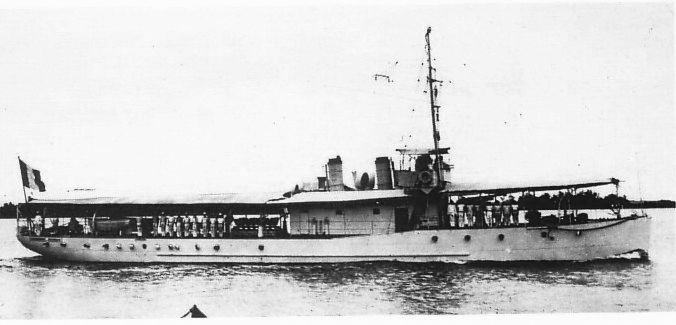
Profile photo of the ex-C-111 (Commandant Bourdais) in Indochina in the interwar, as it became a river gunboat in 1928 – credits Raphodon wikimedia commons (cc)
Specification of the C101 class (1919)
> 128-133 tons FL, 41.4 x 5.2 x 2.4 m, 2 shaft TE, 1300 ihp, 16.5 knots. 1x 75 mm, 1 MG, 8 DC.
Bouvines class patrol vessels (1919)
Named after famous French victories, these eight ships were patrol vessels of the trawler type, ordered in part in Vickers Canada of Montreal and for these eight ones at Fondatio Co. of Savannah which built a yard for them; Delays for it contruction, supplies and organization meant none was ready when the war ended in November 1918. Eventually only the eight more advanced were delivered to the French. Once they arrived, they were put on disposal by the Marine, and sold at auction to civilian owners, spending the rest of their life hunting fish. The other 30 were not scrapped but sold by their yard to the USA, and probably hit the civilian market afterwards too, seeing WW2.
Specification of the Bouvines class (1920)
> 684 tons FL, 45 x 7.8 x ? m, 1 shaft Rpc engine, 500 ihp, 9.5 knots. 2x 100 mm.


 Latest Facebook Entry -
Latest Facebook Entry -  X(Tweeter) Naval Encyclopedia's deck archive
X(Tweeter) Naval Encyclopedia's deck archive Instagram (@navalencyc)
Instagram (@navalencyc)





 French Navy
French Navy Royal Navy
Royal Navy Russian Navy
Russian Navy Armada Espanola
Armada Espanola Austrian Navy
Austrian Navy K.u.K. Kriegsmarine
K.u.K. Kriegsmarine Dansk Marine
Dansk Marine Nautiko Hellenon
Nautiko Hellenon Koninklije Marine 1870
Koninklije Marine 1870 Marinha do Brasil
Marinha do Brasil Osmanlı Donanması
Osmanlı Donanması Marina Do Peru
Marina Do Peru Marinha do Portugal
Marinha do Portugal Regia Marina 1870
Regia Marina 1870 Nihhon Kaigun 1870
Nihhon Kaigun 1870 Preußische Marine 1870
Preußische Marine 1870 Russkiy Flot 1870
Russkiy Flot 1870 Svenska marinen
Svenska marinen Søværnet
Søværnet Union Navy
Union Navy Confederate Navy
Confederate Navy Armada de Argentina
Armada de Argentina Imperial Chinese Navy
Imperial Chinese Navy Marinha do Portugal
Marinha do Portugal Mexico
Mexico Kaiserliche Marine
Kaiserliche Marine 1898 US Navy
1898 US Navy Sovietskiy Flot
Sovietskiy Flot Royal Canadian Navy
Royal Canadian Navy Royal Australian Navy
Royal Australian Navy RNZN Fleet
RNZN Fleet Chinese Navy 1937
Chinese Navy 1937 Kriegsmarine
Kriegsmarine Chilean Navy
Chilean Navy Danish Navy
Danish Navy Finnish Navy
Finnish Navy Hellenic Navy
Hellenic Navy Polish Navy
Polish Navy Romanian Navy
Romanian Navy Turkish Navy
Turkish Navy Royal Yugoslav Navy
Royal Yugoslav Navy Royal Thai Navy
Royal Thai Navy Minor Navies
Minor Navies Albania
Albania Austria
Austria Belgium
Belgium Columbia
Columbia Costa Rica
Costa Rica Cuba
Cuba Czechoslovakia
Czechoslovakia Dominican Republic
Dominican Republic Haiti
Haiti Hungary
Hungary Honduras
Honduras Estonia
Estonia Iceland
Iceland Eire
Eire Equador
Equador Iran
Iran Iraq
Iraq Latvia
Latvia Liberia
Liberia Lithuania
Lithuania Mandchukuo
Mandchukuo Morocco
Morocco Nicaragua
Nicaragua Persia
Persia San Salvador
San Salvador Sarawak
Sarawak Uruguay
Uruguay Venezuela
Venezuela Zanzibar
Zanzibar Warsaw Pact Navies
Warsaw Pact Navies Bulgaria
Bulgaria Hungary
Hungary

 Bundesmarine
Bundesmarine Dutch Navy
Dutch Navy Hellenic Navy
Hellenic Navy Marina Militare
Marina Militare Yugoslav Navy
Yugoslav Navy Chinese Navy
Chinese Navy Indian Navy
Indian Navy Indonesian Navy
Indonesian Navy JMSDF
JMSDF North Korean Navy
North Korean Navy Pakistani Navy
Pakistani Navy Philippines Navy
Philippines Navy ROKN
ROKN Rep. of Singapore Navy
Rep. of Singapore Navy Taiwanese Navy
Taiwanese Navy IDF Navy
IDF Navy Saudi Navy
Saudi Navy Royal New Zealand Navy
Royal New Zealand Navy Egyptian Navy
Egyptian Navy South African Navy
South African Navy






























 Ukrainian Navy
Ukrainian Navy dbodesign
dbodesign